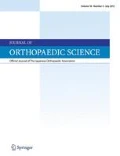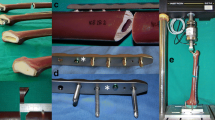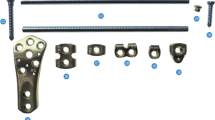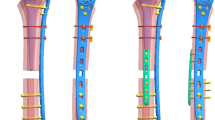Abstract
Background
The incidence of periprosthetic femoral fractures (PFF) around a stable stem is increasing. The aim of this biomechanical study was to examine how three different methods of fixation, for Vancouver type B1 PFF, alter the stiffness and strain of a construct under various configurations, in order to gain a better insight into the optimal fixation method.
Methods
Three different combinations of proximal screws and Dall–Miles cables were used: (A) proximal unicortical locking screws alone; (B) proximal cables and unicortical locking screws; (C) proximal cable alone, each in combination with distal bicortical locking screws, to fix a stainless steel locking compression plate to five synthetic femora with simulated Vancouver type B1 PFFs. In one synthetic femora, there was a 10-mm fracture gap, in order to simulate a comminuted injury. The other four femora had no fracture gap, to simulate a stable injury. An axial load was applied to the constructs at varying degrees of adduction, and the overall construct stiffness and surface strain were measured.
Results
With regards to stiffness, in both the gap and no gap models, method of fixation A was the stiffest form of fixation. The inclusion of the fracture gap reduced the stiffness of the construct quite considerably for all methods of fixation. The strain across both the femur and the plate was considerably less for method of fixation C, compared to A and B, at the locations considered in this study.
Conclusion
This study highlights that the inclusion of cables appears to damage the screw fixations and does not aid in construct stability. Furthermore, the degree of fracture reduction affects the whole construct stability and the bending behaviour of the fixation.





Similar content being viewed by others
References
Berry DJ. Epidemiology: hip and knee. Orthop Clin North Am. 1999;30(2):183–90.
Tsiridis E, Pavlou G, Venkatesh R, Bobak P. Gie, G periprosthetic femoral fractures around hip arthroplasty: current concepts in their management. Hip Int. 2009;19(2):75–86.
Kingdom, N.J.R.U., 2009/2010.
Brady OH, Garbuz DS, Masri BA, Duncan CP. Classification of the hip. Orthop Clin North Am. 1999;30(2):215–20.
Duncan CP, Masri BA. Fractures of the femur after hip replacement. Instr Course Lect. 1995;44:293–304.
Masri BA, Meek RM, Duncan CP. Periprosthetic fractures evaluation and treatment. Clin Orthop Relat Res. 2004;420:80–95.
Gautier E, Sommer C. Guidelines for the clinical application of the LCP. Injury. 2003;34(Suppl 2):B63–76.
Chakravarthy J, Bansal R, Cooper J. Locking plate osteosynthesis for Vancouver Type B1 and Type C periprosthetic fractures of femur: a report on 12 patients. Injury. 2007;38(6):725–33.
Graham SM, Moazen M, Leonidou A, Tsiridis E. Locking plate fixation for Vancouver B1 periprosthetic femoral fractures: a critical analysis of 135 cases. J Orth Sci. 2013;18(3):426–36.
Moazen M, Jones AC, Leonidou A, Jin Z, Wilcox RK, Tsiridis E. Rigid versus flexible plate fixation for periprosthetic femoral fracture-computer modelling of a clinical case. Med Eng Phys. 2012;34:1041–8.
Buttaro MA, Farfalli G, Paredes Nunez M, Comba F, Piccaluga F. Locking compression plate fixation of Vancouver type-B1 periprosthetic femoral fractures. J Bone Joint Surg Am. 2007;89(9):1964–9.
Bottlang M, Doornink J, Lujan TJ, Fitzpatrick DC, Marsh JL, von Augat P, Rechenberg B, Lesser M, Madey SM. Effects of construct stiffness on healing of fractures stabilized with locking plates. J Bone Joint Surg Am. 2010;92(Suppl 2):12–22.
Lujan TL, Henderson CE, Madey SM, Fitzpatrick DC, Marsh JL, Bottlang M. Locked plating of distal femur fracture leads to inconsistent and asymmetric callus formation. J Orthop Trauma. 2010;24:156–62.
Augat P, Merk J, Ignatius A, Margevicius K, Bauer G, Rosenbaum D, Claes L. Early, full weight bearing with flexible fixation delays fracture healing. Clin Orthp Relat Res. 1996;328:194–202.
Moazen M, Mak JH, Etchels LW, Jin Z, Wilcox RK, Jones AC, Tsiridis E. The effect of fracture stability on the performance of locking plate fixation in periprosthetic femoral fractures. J Arthroplast. 2013;28(9):1589–95.
Moazen M, Jones AC, Jin Z, Wilcox RK, Tsiridis E. Periprosthetic fracture fixation of the femur following total hip arthroplasty: a review of biomechanical testing. Clin Biomech. 2011;26:13–22.
Shah S, Kim SYR, Dubov A, Schemitsch EH, Bougherara H, Zdero R. The biomechanics of plate fixation of periprosthetic femoral fractures near the tip of a total hip implant: cables, screws, or both? Proc Inst Mech Eng Part H. 2011;225:845–56.
Haddad FS, Duncan CP, Berry DJ, Lewallen DG, Gross AE, Chandler HP. Periprosthetic femoral fractures around well-fixed implants: use of cortical onlay allografts with or without a plate. J Bone Joint Surg [Am]. 2002;84:945–50.
Sariyilmaz K, Dikici F, Dikmen G, Bozdag E, Sunbuloglu E, Bekler B, Yazicioglu O. The effect of strut allograft and its position on Vancouver type B1 periprosthetic femoral fractures: a biomechanical study. J Arthroplast. 2014;29(7):1485–90.
Moazen M, Mak JH, Etchels LW, Jin Z, Wilcox RK, Jones AC, Tsiridis E. Periprosthetic femoral fracture–a biomechanical comparison between Vancouver type B1 and B2 fixation methods. J Arthroplast. 2014;29(3):495–500.
Neumann D, Thaler C, Born U. Management of Vancouver B2 and B3 femoral periprosthetic fractures using a modular cementless stem without allografting. Int Orthop. 2012;36:1045–50.
Conflict of interest
There are no conflicts of interest.
Author information
Authors and Affiliations
Corresponding author
About this article
Cite this article
Graham, S.M., Mak, J.H., Moazen, M. et al. Periprosthetic femoral fracture fixation: a biomechanical comparison between proximal locking screws and cables. J Orthop Sci 20, 875–880 (2015). https://doi.org/10.1007/s00776-015-0735-3
Received:
Accepted:
Published:
Issue Date:
DOI: https://doi.org/10.1007/s00776-015-0735-3




